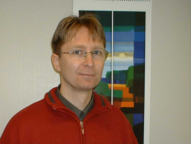Contact mechanics of polymer interfaces: New approaches in testing and control of adhesion
Promotion date: 03-11-2004
| I have been studying the adhesive properties of different polymer surfaces. This was one part of the research and the other was building a device for the adhesion measurements. In the literature this instrument is often referred as JKR adhesion-testing device, but we simply called it ATD. For the studies of surface forces, which intimately relates to the adhesion we have also developed a model material, a kind of artificial latex. |
What is your thesis about?
I have been studying the adhesive properties of different polymer surfaces. This was one part of the research and the other was building a device for the adhesion measurements. In the literature this instrument is often referred as JKR adhesion-testing device, but we simply called it ATD. For the studies of surface forces, which intimately relates to the adhesion we have also developed a model material, a kind of artificial latex.
Why did you develop a new material? Why not use an existing polymer?
Well, we had certain purposes in mind. The most important of all was that we wanted a system as simple as possible. Later, it turned out that by covering the prepared latex spheres with gold particles we could create a kind of material, which is a good candidate for photonic band gap applications. With the development of this material we achieved something, but not quite what we thought. Since latexes are widely used as coatings, we wanted know more about its adhesive properties, which is an important issue for the paint industry for instance: how does the material stick to a particular substrate and that sort of questions. While working on it many interesting side things occurred and we side-stepped.
Haven’t the adhesive properties of polymers not been investigated before?
O, no, there is an enormous amount of literature on the subject. But we approached the matter in a relatively new way and found several new aspects of different surface treatments. There are some groups in the world that apparently have similar angles, I read papers and abstracts about it.
Is there any practical spin off to be expected from your research?
Well, the device we developed may have an interesting practical application. It can be used before applying paint on metal surfaces to determine whether the surface is really oil-free and paint will stick. That will be a major step forward in the quality check in the production line.
And I would like to continue work on the adhesion and other properties of the latex material I developed. I expect many practical applications there as well.
Is there a chance of continuing on it?
Actually I have been working since 1 May in Hungary in my former group and we are doing some work on this subject. I started my PhD in Hungary in this group and only came to Mesa perform measurements. When I arrived I found that here the research is truly scientific whereas in Hungary it is more industry and process related. So I stayed.
I also considered it very important to work abroad, to meet other people and to be able talk about science in a foreign language. Unfortunately I did not continue my excellent Dutch language course at the ROC, so I only acquired a moderate grasp of English.
So you are back in Hungary?
Yes, for a postdoc of about three years. And although I enjoy being back in my home country, the experience in the Netherlands has enriched me in more ways than science alone. I look at many things at home in a more objective way. I know now that not all drivers are so impatient as the Hungarians!

